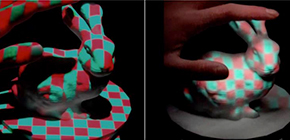
Magic trick makes shadows vanish: projection mapping technique developed to reduce shadow
Researchers at Osaka University develop projection mapping technology that virtually eliminates shadows on a projection surface even if light is blocked by an object
Projection mapping systems that project images onto various-sized curved surfaces ranging from buildings to flowers have been used for scenographic and modern arts since around the turn of the century. The systems are widely utilized not only for entertainment events, but also in clinical practice and technological development.
By projecting images onto a surface from a wide range of directions, a group of researchers led by Kosuke Sato at Osaka University developed a projection system in which few shadows are cast on the projection surface even when the surface is occluded by an object.
This technology was selected as an innovative technology by the Digital Content Association of Japan to be on display at the Digital Content Expo from November 14 through November 16, 2018 in Chiba, Japan.
In projection mapping systems, projected images become invisible when light from a projector is blocked. For this reason, there was a limitation in the use of projection mapping systems: nothing should be between the projector and the projection surface. That is, the projection mapping’s ability to change the appearance and physical presence of objects at will was not able to be fully demonstrated.
Inspired by a surgical light system that does not cast shadows on patients’ bodies in clinical practice, this group used a special optical system that consists of methodically positioned vertical mirrors. This optical system is generally used for forming mid-air images and allows for the enlargement of the projector's aperture to tens of square centimeters in size.
With the use of this optical system for projecting mid-air images onto the projection surface, this group invented a novel mechanism for projection mapping: a mechanism to shed light on the projection surface from various directions.
Daisuke Iwai, an associate professor in the research group, says, “In this new system, visibility of projected imagery is not inhibited even when one touches the projection surface, so it will be used for effective projection mapping advertisements and exhibitions that allow for human interaction. Since guidance images can be projected on the operative area of the patient’s body without any loss of information due to occlusion of the images, this system can be also used as a tool to support operations.”

Figure 1. (Left) normal projection mapping, (Right) proposed shadow-less projection mapping.
Related links
